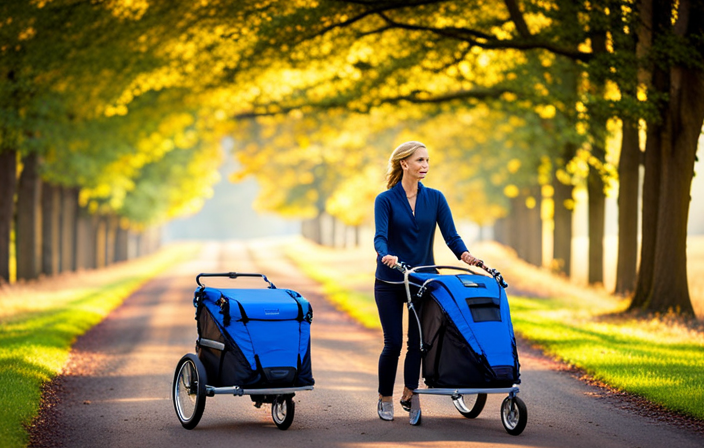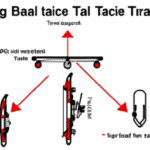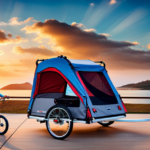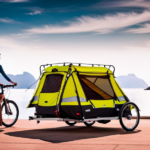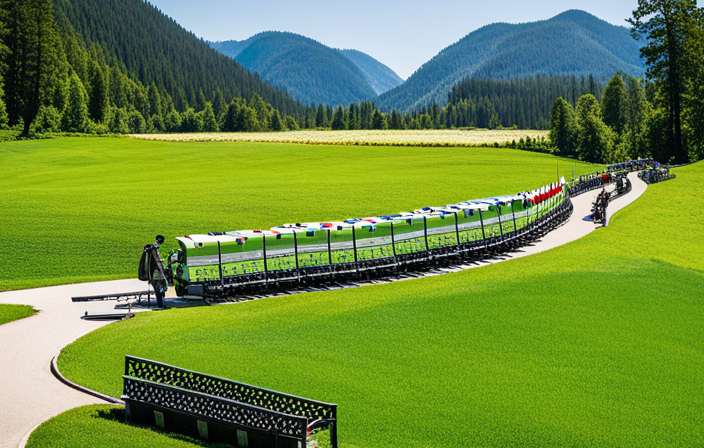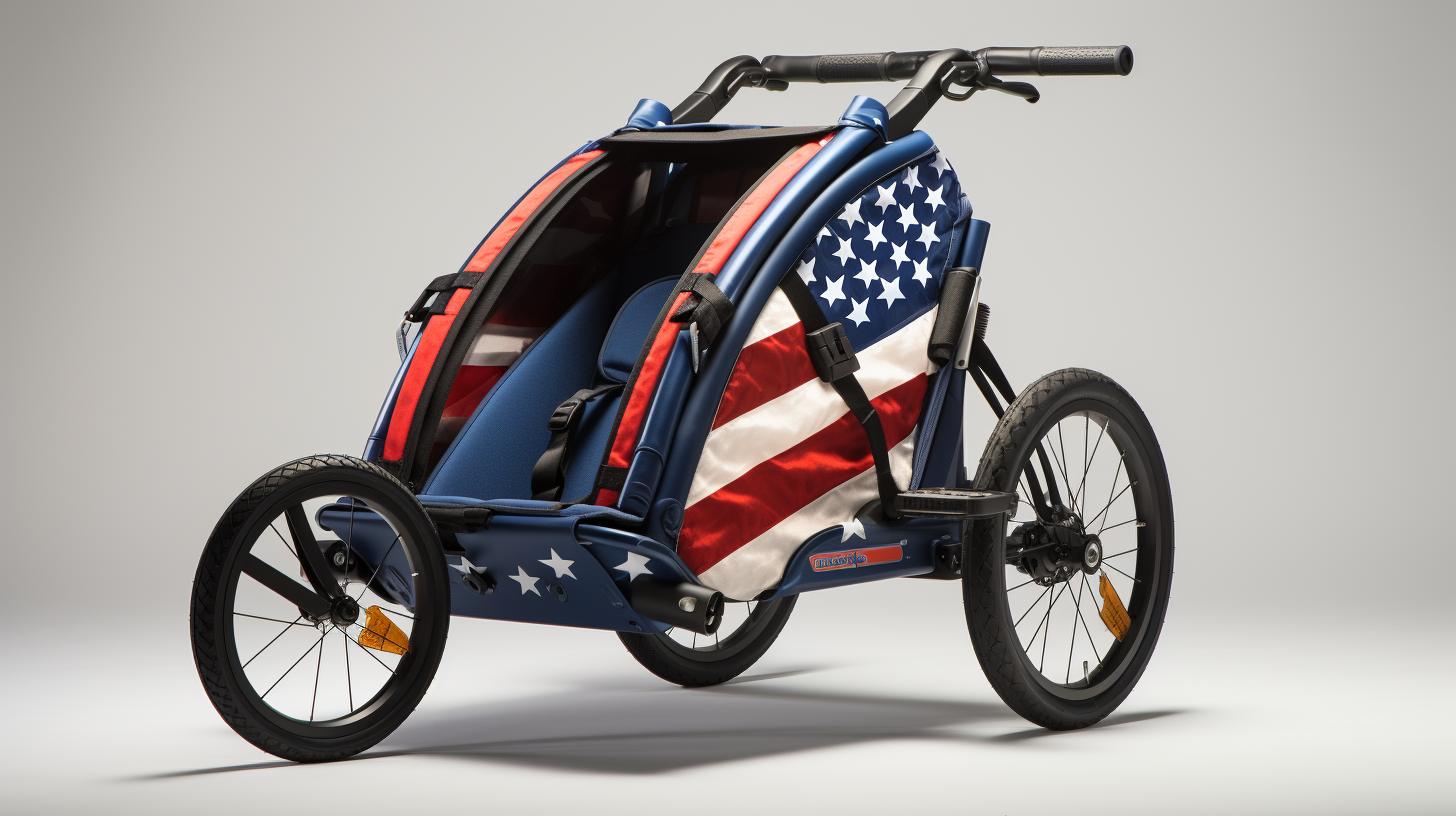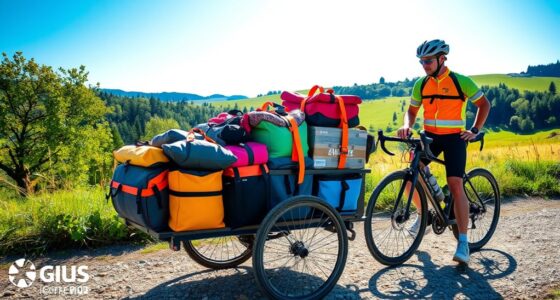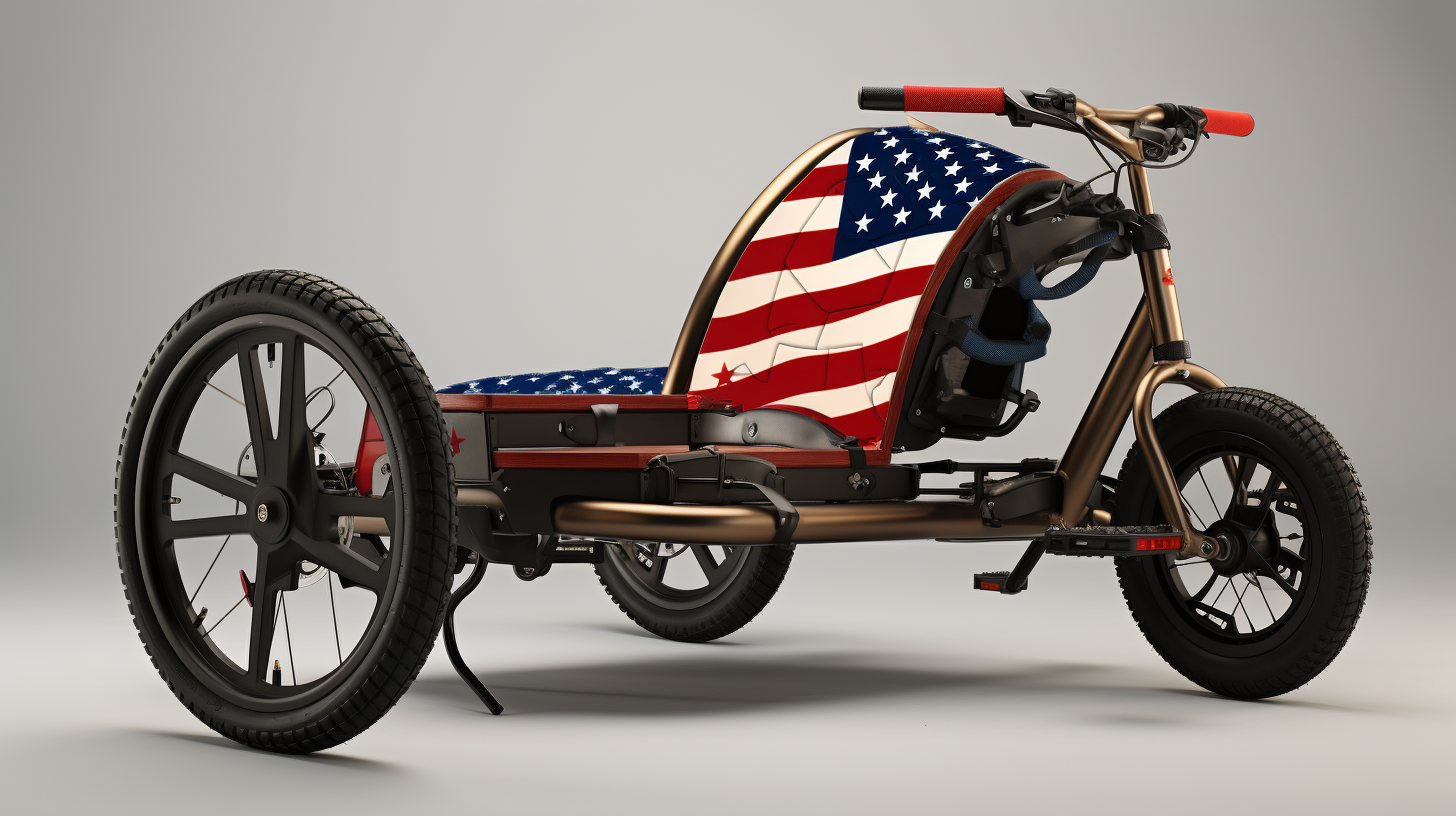As a cyclist, I have always been fascinated by the detailed design and construction of bike trailers. The fabric used in these trailers is a key element that significantly impacts their durability and functionality.
In this article, I’ll delve into the various fabrics commonly employed in bike trailer manufacturing. From lightweight and tear-resistant nylon to waterproof PVC-coated polyester, we’ll explore the technical nuances of each material and their suitability for different biking adventures.
Get ready to unlock the secrets behind the fabrics that make bike trailers a reliable companion on the road.
Key Takeaways
- Nylon fabric is lightweight and durable, making it easier to maneuver and transport bike trailers.
- Polyester fabric is resistant to UV rays and weather conditions, providing long-lasting performance.
- Canvas fabric provides strength and durability for heavy loads, but is not as lightweight or water-resistant as nylon.
- Ripstop fabric prevents tears and punctures, offering excellent strength and durability while remaining lightweight.
Nylon: Lightweight and durable material for bike trailers
Nylon is a lightweight and durable material commonly used to make bike trailers. When it comes to choosing the fabric for a bike trailer, there are two main options: lightweight or heavy duty.
Lightweight nylon fabric is a popular choice for bike trailers due to its advantageous properties. First and foremost, its lightweight nature makes it easier to maneuver and transport. This is especially important when cycling uphill or navigating through tight spaces.
Additionally, nylon fabric is known for its exceptional durability. It can withstand the rigors of outdoor use, such as bumps, scrapes, and even mild weather conditions. This durability ensures that the bike trailer will last for a long time, providing value for money.
Another benefit of using nylon fabric is its resistance to water. It has the ability to repel water, keeping the contents of the trailer dry even during rainy rides. This is particularly useful when transporting delicate or sensitive items.
As we transition into the next section about polyester, it’s important to consider the importance of UV resistance and weather conditions when choosing the fabric for a bike trailer.
Polyester: Resistant to UV rays and weather conditions
Polyester is a great choice for your bike trailer because it’s resistant to UV rays and weather conditions. When it comes to choosing the right fabric for bike trailers, the decision between polyester and nylon can be tricky. Both fabrics have their own advantages, but polyester stands out for its exceptional durability and ability to withstand the elements.
Polyester is known for its resistance to UV rays, which means it won’t fade or degrade quickly when exposed to sunlight. This is crucial for bike trailers that spend a lot of time outdoors. Additionally, polyester is highly resistant to water, making it ideal for riding in rainy conditions. It won’t absorb water like nylon, which can result in added weight and potential damage to the trailer.
The impact of fabric choice on the performance of bike trailers cannot be underestimated. The durability and weather resistance of polyester make it a reliable option, ensuring that your bike trailer will last for years to come. Its ability to withstand the harsh elements means you can confidently take your trailer on any adventure without worrying about its performance being compromised.
Transitioning to the subsequent section about canvas, it’s important to note that this fabric provides strength and durability for heavy loads, making it another excellent choice for bike trailers.
Canvas: Provides strength and durability for heavy loads
When choosing your material for a bike trailer, canvas stands out as a reliable option, offering strength and durability for heavy loads. Canvas fabric is known for its exceptional strength, making it ideal for carrying heavy items. It can withstand the weight and pressure of the load without tearing or breaking. The durability of canvas fabric ensures that it can withstand the rigors of regular use, making it a long-lasting choice for bike trailers.
However, canvas does have its drawbacks. One potential con is that it is not as lightweight as other materials like nylon. This can make the bike trailer heavier to pull and may affect the overall performance. Additionally, canvas fabric is not as resistant to water as nylon, so it may not be the ideal choice for biking in wet or rainy conditions.
When comparing canvas to nylon, both fabrics have their strengths and weaknesses. While canvas offers superior strength and durability, nylon is lighter and more water-resistant. The choice between the two depends on your specific needs and preferences.
Transition: Now that we have explored the pros and cons of canvas fabric for bike trailers, let’s move on to ripstop, a feature that prevents tears and punctures in the fabric.
Ripstop: Prevents tears and punctures in the fabric
Canvas fabric with ripstop technology prevents tears and punctures, ensuring the longevity of the material. When it comes to tear resistance, ripstop fabric outperforms ballistic nylon. The unique ripstop weave consists of reinforced threads woven into the fabric in a grid pattern, making it highly resistant to tears and punctures. This is crucial for bike trailers, as they are subjected to rough terrains and heavy loads.
To better understand the tear resistance capabilities of ripstop fabric compared to ballistic nylon, let’s take a look at the following table:
| Ripstop Fabric | Ballistic Nylon | |
|---|---|---|
| Strength | Excellent | Good |
| Durability | High | Moderate |
| Weight | Lightweight | Moderate |
| Cost | Affordable | Expensive |
As you can see, ripstop fabric offers excellent strength and durability, making it an ideal choice for bike trailers. It is also lightweight, which ensures that the trailer remains maneuverable and doesn’t add unnecessary weight to your bike.
When choosing the right fabric for your bike trailer, factors such as tear resistance, durability, weight, and cost should be considered. Ripstop fabric checks all these boxes, making it a reliable and practical choice.
Moving on to the next section about PVC-coated polyester, this fabric offers waterproof properties and easy cleaning.
PVC-Coated Polyester: Waterproof and easy to clean
PVC-coated polyester is a popular choice for outdoor gear due to its waterproof properties and ease of cleaning. When it comes to bike trailers, PVC-coated polyester offers several advantages over other fabrics such as nylon and canvas.
Compared to nylon, PVC-coated polyester is more resistant to water. This is because the PVC coating creates a barrier that prevents water from seeping into the fabric. This is especially important for bike trailers because they are often exposed to rain and other wet conditions. Additionally, PVC-coated polyester is easier to clean than nylon. It can be simply wiped down with a damp cloth or rinsed off with water, making maintenance a breeze.
When compared to canvas, PVC-coated polyester also has the upper hand. While canvas is known for its durability, it is not as waterproof as PVC-coated polyester. Canvas can absorb water, leading to a heavier and potentially damaged bike trailer. PVC-coated polyester, on the other hand, repels water, keeping the trailer dry and lightweight.
In conclusion, PVC-coated polyester is an excellent choice for bike trailers due to its waterproof properties and easy cleaning. It outperforms both nylon and canvas in terms of water resistance, making it a reliable option for outdoor gear.
Now, let’s explore another important feature of bike trailers: mesh, which offers breathability and ventilation for cargo or passengers.
Mesh: Offers breathability and ventilation for cargo or passengers
Moving on from the previous subtopic of PVC-Coated Polyester, let’s explore another fabric option used in making bike trailers: Mesh. Mesh fabric is an excellent choice when breathability and ventilation are essential for cargo or passengers.
Mesh is a lightweight and durable material that allows air to flow freely through the trailer, preventing any stuffiness or discomfort. Its open-weave construction provides excellent ventilation options, ensuring that the cargo or passengers inside the trailer remain cool and comfortable even during hot summer rides.
To better understand the benefits of using mesh fabric in bike trailers, let’s take a closer look at a comparison table:
| Feature | Mesh Fabric | PVC-Coated Polyester | Cordura |
|---|---|---|---|
| Breathability | Excellent | Limited | Moderate |
| Durability | Moderate | High | High |
| Water Resistance | Limited | Excellent | Good |
| Easy to Clean | Yes | Yes | Yes |
| Passenger Comfort | Excellent | Moderate | Good |
As you can see, mesh fabric excels in breathability and passenger comfort, making it an ideal choice for bike trailers. However, its durability may be slightly lower compared to PVC-coated polyester or Cordura.
Now, let’s transition to the subsequent section about Cordura, an abrasion-resistant fabric perfect for tackling rugged terrains.
Cordura: Abrasion-resistant fabric for rugged terrains
When it comes to durability and tackling rugged terrains, Cordura is your go-to choice for a bike trailer. Cordura is a highly durable fabric that is known for its exceptional strength and resistance to abrasion. Compared to nylon, Cordura offers superior toughness and can withstand the harshest conditions that bike trailers may encounter.
One advantage of using Cordura in bike trailer fabric is its exceptional abrasion resistance. It can withstand heavy usage and rough terrains without showing signs of wear and tear. This makes it an ideal choice for bike trailers that are frequently used in off-road adventures or for transporting heavy loads.
Additionally, Cordura is known for its excellent tear strength, making it highly resistant to ripping or puncturing. This ensures that the fabric will not easily give way under pressure, providing added safety and security for your cargo or passengers.
However, it is important to note that Cordura is not completely waterproof. While it does have some water resistance, it may not provide adequate protection during heavy rainfall or prolonged exposure to moisture. This is where tarpaulin, a waterproof material for protecting cargo from rain, comes into play.
Tarpaulin is a durable and waterproof fabric that can be used as a cover for your bike trailer. It ensures that your cargo remains dry even in the wettest conditions, keeping it safe from water damage.
Tarpaulin: Waterproof material for protecting cargo from rain
Tarpaulin is a great choice for keeping your cargo dry in rainy conditions. It is a waterproof material that provides excellent protection against moisture, making it ideal for bike trailers. There are several advantages to using tarpaulin for bike trailers.
Firstly, it is highly durable and can withstand rough usage and harsh weather conditions. This means that your cargo will remain safe and dry, even when you are riding through rugged terrains or heavy rain. Additionally, tarpaulin is lightweight, which ensures that it does not add unnecessary weight to your bike trailer. This is especially important if you are carrying heavy loads or traveling long distances.
When choosing the right tarpaulin for your bike trailer, there are a few factors to consider. Firstly, opt for a tarpaulin that is made from high-quality materials to ensure maximum durability and longevity. Look for a tarpaulin that is reinforced with strong stitching or welded seams for added strength. Additionally, choose a tarpaulin that is UV resistant to prevent fading and degradation from sun exposure. Lastly, consider the size of the tarpaulin to ensure that it can adequately cover and protect your cargo.
Transitioning into the subsequent section about oxford cloth: strong and tear-resistant fabric for long-lasting use, it is important to consider all the options available when selecting the right material for your bike trailer.
Oxford Cloth: Strong and tear-resistant fabric for long-lasting use
For a durable and long-lasting option, consider oxford cloth when selecting the material for your cargo protection. Oxford cloth is a popular choice for bike trailers due to its numerous advantages.
Firstly, it is incredibly strong and tear-resistant, ensuring that your cargo remains secure and protected during transportation. This fabric is specifically designed to withstand heavy loads and rough handling, making it ideal for outdoor activities such as biking.
Additionally, oxford cloth offers excellent water resistance, keeping your cargo dry even in wet weather conditions. This is especially important when transporting sensitive items that can be damaged by moisture.
Compared to other fabric materials used in bike trailers, oxford cloth stands out in terms of its durability and longevity. It is more resistant to wear and tear, making it less likely to rip or fray over time. Furthermore, oxford cloth is relatively lightweight, making it easier to handle and maneuver. This is particularly beneficial when loading and unloading the trailer or when navigating through tight spaces.
Transitioning to the next section, another fabric material worth considering for bike trailers is polypropylene. It offers the advantages of being lightweight and resistant to moisture and chemicals.
Polypropylene: Lightweight and resistant to moisture and chemicals
Polypropylene is a great option for its lightweight nature and resistance to moisture and chemicals. When it comes to fabric choices for bike trailers, polypropylene stands out for its numerous advantages. Firstly, its lightweight nature makes it easy to handle and maneuver. This is especially important when it comes to bike trailers, as you want to keep the overall weight as low as possible for better performance. Additionally, polypropylene is highly resistant to moisture, making it suitable for outdoor use where trailers may be exposed to rain or other forms of precipitation. Its resistance to chemicals is another noteworthy advantage, as it ensures the fabric won’t deteriorate or weaken when in contact with various substances.
To further illustrate the advantages of polypropylene, let’s take a closer look at a table highlighting its key characteristics:
| Advantages | Disadvantages |
|---|---|
| Lightweight | Limited color options |
| Moisture-resistant | Low UV resistance |
| Chemical-resistant | Prone to static cling |
Despite its numerous advantages, polypropylene does have a few disadvantages. One of them is the limited color options available. Unlike some other fabrics, polypropylene is not easily dyeable, which may restrict your choices when it comes to aesthetics. Additionally, polypropylene has low UV resistance, meaning it may fade or degrade when exposed to sunlight for extended periods of time. Finally, polypropylene is prone to static cling, which can be an inconvenience in certain situations.
Transitioning to the subsequent section about vinyl, we can explore another fabric option that is water-resistant and easy to maintain.
Vinyl: Water-resistant and easy to maintain
Vinyl is a popular choice for bike trailers due to its water-resistant properties and ease of maintenance. There are several advantages to using vinyl fabric. Firstly, vinyl is highly water-resistant, making it ideal for outdoor use. It can withstand rain, snow, and other forms of moisture without getting damaged or developing mold and mildew.
Another advantage of vinyl is its easy maintenance. A simple wipe down with a damp cloth is usually enough to remove dirt and stains. Additionally, vinyl fabric is durable and resistant to tears and punctures, ensuring that the bike trailer remains in good condition for a long time.
Vinyl fabric also comes in different types, such as clear vinyl and marine-grade vinyl. Clear vinyl allows for better visibility of the cargo inside the trailer, while marine-grade vinyl is designed to withstand the harsh conditions of marine environments.
In conclusion, the water-resistant properties, ease of maintenance, and availability in different types make vinyl fabric a popular choice among cyclists for their bike trailers.
Moving onto the next fabric option, durable denim provides a classic look and good durability.
Durable Denim: Provides a classic look and good durability
Denim is a popular choice for bike trailers due to its classic look and durability. This fabric, which has been a staple in the fashion industry for decades, brings the same benefits to the world of bike trailers. Here are some reasons why durable denim is a classic and durable fabric for bike trailers:
-
Strength: Denim is made from tightly woven cotton fibers, giving it excellent strength and resistance to tearing. This makes it ideal for withstanding the rigors of outdoor use and carrying heavy loads.
-
Durability: The sturdy construction of denim ensures that it can withstand regular use and exposure to various weather conditions. It is resistant to abrasion, making it less likely to develop rips or holes over time.
-
Style: Denim’s timeless and versatile look adds a touch of classic style to bike trailers. It can easily complement different bike designs and personal aesthetics.
-
Easy Maintenance: Denim is relatively easy to clean and maintain. It can be spot cleaned or machine washed, and it doesn’t require any special treatments or detergents.
Transitioning to the next section about thermoplastic polyurethane (TPU), this flexible and resistant material offers a range of benefits for bike trailers.
Thermoplastic Polyurethane (TPU): Flexible and resistant to abrasion and chemicals
When considering options for your bike trailer, you’ll find that thermoplastic polyurethane (TPU) offers the benefits of flexibility and resistance to abrasion and chemicals.
TPU is a versatile material that has gained popularity in the manufacturing of bike trailers due to its exceptional properties. One of the key benefits of using TPU in bike trailer construction is its flexibility. This allows the trailer to withstand various terrains and movements without compromising its structural integrity.
Additionally, TPU is highly resistant to abrasion and chemicals, making it a durable choice for outdoor use. Compared to other materials commonly used in bike trailer manufacturing, such as PVC or nylon, TPU offers superior resistance and longevity. PVC can become brittle over time, while nylon may not withstand harsh chemicals or weather conditions as effectively as TPU.
In conclusion, TPU is an excellent choice for bike trailer construction due to its flexibility and resistance to abrasion and chemicals.
Now, let’s move on to discussing another material option for bike trailers: waxed canvas.
Waxed Canvas: Water-resistant and ages well over time
If you’re looking for a material that ages well over time and offers water-resistance, waxed canvas is a great option to consider. When it comes to bike trailers, using waxed canvas has numerous benefits.
First and foremost, waxed canvas is naturally water-resistant due to the wax coating applied to the fabric. This means that your bike trailer and its contents will stay dry even in wet weather conditions. Additionally, waxed canvas is known for its durability and longevity. It is a tough and rugged fabric that can withstand the demands of outdoor activities, making it ideal for bike trailers that are often subjected to rough terrains and heavy loads.
To care for and maintain waxed canvas bike trailers, there are a few key things to keep in mind. First, avoid machine washing or dry cleaning the trailer as it can damage the wax coating. Instead, gently wipe off any dirt or stains with a damp cloth. If necessary, you can use a mild soap or canvas cleaner specifically designed for waxed canvas. It’s important to allow the trailer to air dry completely before storing it away. Lastly, to preserve the water-resistance of the fabric, you may need to reapply wax to the canvas periodically. This can be done by using a wax bar or by applying a wax spray.
In conclusion, waxed canvas is a fantastic choice for bike trailers due to its water-resistance, durability, and ability to age well over time. By following the proper care and maintenance guidelines, you can ensure that your waxed canvas bike trailer remains in excellent condition for years to come.
Now, let’s move on to discussing another heavy-duty fabric for maximum strength and durability: ballistic nylon.
Ballistic Nylon: Heavy-duty fabric for maximum strength and durability
After exploring the water-resistant and aging properties of waxed canvas, let’s delve into another fabric option for bike trailers: ballistic nylon. Known for its heavy-duty nature, ballistic nylon is widely used in various industries, including the military and outdoor gear manufacturing.
When comparing ballistic nylon to canvas in terms of strength and durability, ballistic nylon takes the lead. Its tight weave and high denier count make it exceptionally resistant to tearing, punctures, and abrasions. This strength is especially crucial for bike trailers, as they are subjected to constant movement, weather conditions, and potential impact.
In addition to its superior strength, ballistic nylon also offers excellent durability. It is highly resistant to fading, UV rays, and moisture, making it ideal for outdoor applications. This fabric’s ability to withstand harsh environments ensures that your bike trailer remains intact and functional for longer periods.
On the flip side, one disadvantage of ballistic nylon is its weight. Due to its thick and robust nature, it can add significant bulk to the overall weight of the bike trailer. This may not be a concern for some users, but for those seeking a lightweight option, ballistic nylon might not be the best choice.
Another popular fabric used in bike trailers is ripstop fabric. Ripstop fabric is woven using a special technique that reinforces it with larger, thicker threads at regular intervals. This prevents small tears or punctures from spreading and causing further damage. The main advantage of using ripstop fabric for bike trailers is its enhanced durability and resistance to tearing. This makes it an excellent choice for off-road adventures or rough terrains where the trailer may encounter sharp objects or branches.
However, ripstop fabric can be slightly heavier and more expensive than other options, and some users may find its grid-like pattern less aesthetically pleasing. Overall, the decision between ballistic nylon and ripstop fabric ultimately depends on your specific needs and preferences.
Frequently Asked Questions
Are there any fabric options that are specifically designed for heavy loads in bike trailers?
Yes, there are fabric options specifically designed for heavy loads in bike trailers. These fabrics are known for their exceptional durability and strength, making them ideal for carrying heavy loads.
They are typically made from high-quality materials such as reinforced nylon or polyester. These fabrics undergo rigorous testing to ensure they can withstand the stress and strain of heavy loads, providing a reliable and long-lasting solution for bike trailers that need to transport heavy items.
Are there any fabric options that provide breathability and ventilation for cargo or passengers?
One example of a fabric option that provides breathability and ventilation for cargo or passengers is mesh fabric.
Mesh fabric is a lightweight and breathable material that allows air to circulate freely, preventing heat buildup and promoting airflow.
It is commonly used in outdoor gear such as backpacks and tents to provide ventilation.
Incorporating mesh panels or using mesh fabric for certain sections of a bike trailer can help ensure that cargo or passengers stay cool and comfortable during rides.
Is there a fabric option that is resistant to tears and punctures?
Yes, there is a fabric option that provides resistance to abrasion and durability. This fabric is typically made from high-strength materials such as nylon or polyester, which have excellent tear and puncture resistance.
The fabric undergoes a special treatment process, such as coating or laminating, to enhance its durability. These fabric options offer optimal protection against tears and punctures, making them ideal for bike trailers that require long-lasting performance in rugged conditions.
Are there any fabric options that are waterproof and easy to clean?
There are fabric options available that are specifically designed to be waterproof and easy to clean. These fabrics have a special coating or treatment that prevents water from penetrating the material, keeping the contents of the bike trailer dry even in wet conditions.
Additionally, the fabric is designed to be easily wiped clean with a damp cloth or sponge, making maintenance and cleaning a breeze.
These waterproof and easy to clean fabrics are ideal for bike trailers as they provide protection and convenience.
Is there a fabric option that offers protection from UV rays and various weather conditions?
Choosing a durable and long-lasting fabric for bike trailers is crucial. When considering protection from UV rays and various weather conditions, two options stand out: UV resistant fabric and weather resistant fabric.
UV resistant fabric shields your trailer from harmful rays, while weather resistant fabric ensures protection from rain, wind, and other harsh elements.
It’s vital to weigh the benefits of each, ensuring your bike trailer remains sturdy and dependable in any environment.
Conclusion
In conclusion, the choice of fabric for bike trailers is crucial for their performance and longevity. After thorough research, it is clear that nylon, polyester, canvas, ripstop, PVC-coated polyester, durable denim, thermoplastic polyurethane (TPU), waxed canvas, and ballistic nylon are all excellent options.
Each fabric possesses unique qualities that contribute to lightweightness, durability, weather resistance, tear prevention, waterproofing, flexibility, abrasion resistance, and strength.
Careful consideration of these factors will ensure the construction of bike trailers that are reliable, safe, and built to withstand the elements.
